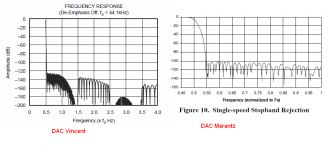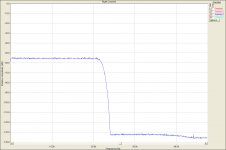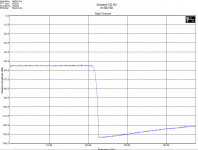Not really - the explanation for the apparent modulation of signals whose frequency are very close to the Nyquist frequency comes out of modulation theory. Basically we are moving from AM to SSB.
Seems that could be. However, still looks like the amplitude and settling time increasing.
THx-RNMarsh
No problems George, it is the playback, I am really too brief in my posts and I prefer images over explanations.
Someone might say "no problem, inaudible". But please think about intermodulation products in tweeters and I can guarantee these examples will and do create audible intermodulation products in tweeters.
Same problem.... sometimes the dots i leave are too far apart to make the picture.
THx-RNMarsh
Again, I get back to the my original question--why are we talking about NOS DACs?
http://www.analog.com/media/cn/training-seminars/tutorials/MT-017.pdf
http://www.analog.com/media/cn/training-seminars/tutorials/MT-017.pdf
Maybe you were using ARCNet or something, it clearly wasn't Ethernet.
It wasn't called Ethernet till much later after many issues were standardized. The original system run just under 3 megabits per second. When the standard was written they started at 10.
The cabling was originally installed for IBM's Arcnet but moved to what became Internet standards.
Also was using the system for email to the west coast friends at selective places. All mid 70's.
My ID was ES07 @ CMU starting in 71. Arpanet connections on what would become the internet had started before fall 71.
Again, I get back to the my original question--why are we talking about NOS DACs?
http://www.analog.com/media/cn/training-seminars/tutorials/MT-017.pdf
All examples measured on oversampling DACs.
The samples I have measured are over-sampling as well. The ML-9600 is x128 times.
However, people here have gone right by the issue that isnt dealt with in CD's..... Group Delay. This messes up the sound the most ('messes up' is a obscure technical word for which i cant remember the source. Maybe it was SW .
.
We can EQ for flat in digital or analog domains for flat freq response. But not the audible affects of G-D. At least I dont know of it being done in CD players.
With wider BW from 24/96 or more we get the GD flatter below 20KHz.
GD has long been known and dealt with in the communications industry/field where I first practiced it for the military many years ago. Why not here? Well, computing power and costs.
https://books.google.com/books?id=U...=group delay of Compact Disc filters?&f=false
Take a closer look at it because what you will find carries over into speaker systems and other products.
THx-RNMarsh
However, people here have gone right by the issue that isnt dealt with in CD's..... Group Delay. This messes up the sound the most ('messes up' is a obscure technical word for which i cant remember the source. Maybe it was SW
We can EQ for flat in digital or analog domains for flat freq response. But not the audible affects of G-D. At least I dont know of it being done in CD players.
With wider BW from 24/96 or more we get the GD flatter below 20KHz.
GD has long been known and dealt with in the communications industry/field where I first practiced it for the military many years ago. Why not here? Well, computing power and costs.
https://books.google.com/books?id=U...=group delay of Compact Disc filters?&f=false
Take a closer look at it because what you will find carries over into speaker systems and other products.
THx-RNMarsh
Last edited:
All examples measured on oversampling DACs.
Wow--something is amiss with that filter set and the oversampling noise-shaping algorithm in your DAC, because that image should be pushed way, way up. I'm wondering how it is configured, in your case.
The stopband under NOS conditions (and even 2x OS, IMO) is way too narrow to get a good 60-80db (or 100-120 if we're getting picky!) of attenuation from 20k to FS/2, but at 4x and 8x OS, you have room to get there. This also pushes any analog filters north in frequency, too.
RNMarsh--I am not seeing anything that looks like an image in your traces.
Last edited:
Richard,
Your going to get into an area that has little agreement when you bring up GD and phase shift. There are many who say it is not a problem outside of a narrow band in our most critical hearing range and at the extremes makes little to no difference in perceived sound quality. So many speakers have massive GD and especially when you get into multiple drivers such as 3 and 4 way systems and there phase shifting xo networks. I am not taking a side in this but I can see the arguments and disagreements coming for days on end about that subject.
I'm sure someone is going to point you to the work by Earl Geddes and his work showing that except for at the crossover frequency he does not agree. I think people are all over the place about this and I can see that in other threads where phase response is as important to them and FR across the entire audio range.
Your going to get into an area that has little agreement when you bring up GD and phase shift. There are many who say it is not a problem outside of a narrow band in our most critical hearing range and at the extremes makes little to no difference in perceived sound quality. So many speakers have massive GD and especially when you get into multiple drivers such as 3 and 4 way systems and there phase shifting xo networks. I am not taking a side in this but I can see the arguments and disagreements coming for days on end about that subject.
I'm sure someone is going to point you to the work by Earl Geddes and his work showing that except for at the crossover frequency he does not agree. I think people are all over the place about this and I can see that in other threads where phase response is as important to them and FR across the entire audio range.
It wasn't called Ethernet till much later after many issues were standardized. The original system run just under 3 megabits per second. When the standard was written they started at 10.
Correct, there was an early version of Ethernet that ran at 2.94Mb/s, but it only ran at Xerox PARC and was described in a 1976 paper. When Ethernet was released as a product (pre IEEE 802) it was all 10Mb/s.
The cabling was originally installed for IBM's Arcnet but moved to what became Internet standards.
ARCnet was not IBM's, it was made by Datapoint, though as a token-passing scheme it had a very slight resemblance to Token Ring (except for the ring). ARCnet came out in 1977.
None of this has anything to do with the Internet, which is based on TCP/IP, which is agnostic about low-level protocols. TCP/IP can run on any of the network topologies we have discussed. I don't know what any of this has to do with CD's and I am not aware of any widely deployed LAN protocols that ran at 1Mb/s.
Wow--something is amiss with that filter set and the oversampling noise-shaping algorithm in your DAC, because that image should be pushed way, way up. I'm wondering how it is configured, in your case.
The stopband under NOS conditions (and even 2x OS, IMO) is way too narrow to get a good 60-80db (or 100-120 if we're getting picky!) of attenuation from 20k to FS/2, but at 4x and 8x OS, you have room to get there. This also pushes any analog filters north in frequency, too.
RNMarsh--I am not seeing anything that looks like an image in your traces.
There is no way to avoid 22kHz brickwall in oversampling DAC. 22kHz brickwall is used as a reconstruction digital interpolation filter, to calculate values of inserted data points (inserted for oversampling). You only have some free space in output analog LPF with oversampling. Not with digital reconstruction filter.
Vincent CD shows no mirror with 21kHz sine, Marantz CD has a mirror frequency. Exactly according to DACs used.
Results shown are in conformance with datasheets.
Measured are soundcards and conventional players. Stop band and mirrors differ according to DACs used. In the attached image, the DAC on the left has no issues with mirror frequencies. Please note its stop band starts below 0.5 Fs. But the DAC on the right has issues, stop band starts at 0.55 Fs. So signals with frequencies close to Fs/2 create mirrors.
Vincent CD has no mirror of 21kHz sine, Marantz CD has the mirror spectral line. Just according to DACs used. Check the stopband frequency - 22kHz vs. 24kHz.
Attachments
Last edited:
Correct, there was an early version of Ethernet that ran at 2.94Mb/s, but it only ran at Xerox PARC and was described in a 1976 paper. When Ethernet was released as a product (pre IEEE 802) it was all 10Mb/s.
ARCnet was not IBM's, it was made by Datapoint, though as a token-passing scheme it had a very slight resemblance to Token Ring (except for the ring). ARCnet came out in 1977.
None of this has anything to do with the Internet, which is based on TCP/IP, which is agnostic about low-level protocols. TCP/IP can run on any of the network topologies we have discussed. I don't know what any of this has to do with CD's and I am not aware of any widely deployed LAN protocols that ran at 1Mb/s.
Not sure where you were playing. We had Xerox Altos networked and they probably would have been the 2.94 MB for the local net.
As to the original wiring it may have been token ring, but of course all this was running in development mode.
Has to do with how the early CDs were encoded as 9 +7 bits, until you diverted things.
The samples I have measured are over-sampling as well. The ML-9600 is x128 times.
However, people here have gone right by the issue that isnt dealt with in CD's..... Group Delay. This messes up the sound the most ('messes up' is a obscure technical word for which i cant remember the source. Maybe it was SW.
We can EQ for flat in digital or analog domains for flat freq response. But not the audible affects of G-D. At least I dont know of it being done in CD players.
With wider BW from 24/96 or more we get the GD flatter below 20KHz.
GD has long been known and dealt with in the communications industry/field where I first practiced it for the military many years ago. Why not here? Well, computing power and costs.
https://books.google.com/books?id=U...=group delay of Compact Disc filters?&f=false
Take a closer look at it because what you will find carries over into speaker systems and other products.
THx-RNMarsh
What you find in the cited reference is unfortunately bollocks such as this:

Several myths here;
(1) While analog filters that one finds in audio gear are usually very primitive in the cosmic scheme of things, they don't have to be that way because they are analog. It was the cost of implementation and the lack of sophistication of the designers (usually more of the former) that made things traditionally this way. Time delays, phase shifts, and steep slopes are all possible in the analog domain. It is just that such filters are costly and complex to implement in the analog domain.
When I was in my early 20's I worked with Doppler RADARs in the Hawk Missile system (an exceptionally long lived missile system that was initially implemented in the late 1950s and was still in use in Y2k) There were many different versions of it, and the one I worked on (the second version) was basically tubed. Two of the RADARs I maintained had about 400 tubes each. There were many circuits in that classified system that I only otherwise saw in some of the most advanced engineering texts in existence.
(2) The ear's tolerance for group delay is tremendous, especially >> 1 KHz where it basically lacks the hardware to discern phase. If phase shift or group delay are applied equally to all audible sources, > 1,000 degrees of it will completely slip by well-trained listener, even at lower frequencies.
Wow--something is amiss with that filter set and the oversampling noise-shaping algorithm in your DAC, because that image should be pushed way, way up. I'm wondering how it is configured, in your case.
Part of the problem may be that Alesis, the developers of this product don't have the best reputation in the business for effective use of technology.
One of their products, an analog compander is well known among many audio professionals as the worst sounding example of its kind of equipment that was ever made.
I've owned some of their equipment and it was just fine, but that was not a unversal rule for all of their gear.
No, it was over coax and 1 megabit, although it really was just before what is now known as "thicknet" which was 10 megabit. Used a special variant of RG8 cable. Vampire taps didn't come in until a bit latter.
The usage made it terribly slow and interchangeable hard drives were common on the original Xerox Alto work stations and similar 14" hard drives.
Since there seems to be some questioning of these items, I can confirm them both.
Once upon a time I installed and enhanced thinnet ethernet networks that were part of PC networks.
Interchangable hard drives were inherited by minicomputers from mainframes. I maintained the gear that supported them in the 1960s when I worked for IBM.
https://www-03.ibm.com/ibm/history/exhibits/storage/storage_1311.html
Richard, PMA, everybody, what to say of the so-called real time DACs, which are made of 8 pralalled DACs, and are said to use no oversampling and no brickwall filters for better audio performance?
I own one such external device made in Australia, using 8 Philips 1543 DACs, and I can attest that it does indeed sound more relaxed and easier on the ears than classic DAC schemes. However, while the sund is better than usual, the overall performance of my NAD C 565BEE player with a Wolfson DAC sounds better yet.
I own one such external device made in Australia, using 8 Philips 1543 DACs, and I can attest that it does indeed sound more relaxed and easier on the ears than classic DAC schemes. However, while the sund is better than usual, the overall performance of my NAD C 565BEE player with a Wolfson DAC sounds better yet.
Richard, PMA, everybody, what to say of the so-called real time DACs, which are made of 8 pralalled DACs, and are said to use no oversampling and no brickwall filters for better audio performance?
The 8 paralleled DACs are used because each of them all by itself has, in the opinion of its designer insufficient dynamic range. This has nothing to do with oversampling or not, it has to do with trying to squeeze a certain higher level of performance out of low performance parts.
The same technique has been used many times in many products over the years. Currently ESS is using it with their oversampled DACs for the same purpose.
If the noise in the DACs is uncorrelated, their dynamic range goes up by 3 dB every time the number of DACs that are summmed together is doubled.
According to their spec sheet http://www.docethifi.com/TDA1543_.PDF
According to Philips (please see reference), these are econo-grade DACs with relatively poor performance and relatively high nonlinearity which probably explains the designers perceived need to parrallel them. However, looking at their spec sheets, their performance is poor enough (econo-grade CD player) that more would seem to be required for high end performance.
I own one such external device made in Australia, using 8 Philips 1543 DACs, and I can attest that it does indeed sound more relaxed and easier on the ears than classic DAC schemes. However, while the sund is better than usual, the overall performance of my NAD C 565BEE player with a Wolfson DAC sounds better yet.
Two words: sighted evaluation.
What you find in the cited reference is unfortunately bollocks such as this:
(2) The ear's tolerance for group delay is tremendous, especially >> 1 KHz where it basically lacks the hardware to discern phase. If phase shift or group delay are applied equally to all audible sources, > 1,000 degrees of it will completely slip by well-trained listener, even at lower frequencies.
Get the book i've mentioned before on the most up to date knowledge of phychoacoustics in hearing group delay. Thats all i will say as the experts have spoken (written).
BTW -- There are a few players which use powerful dsp engines and FIR filters, allowing for group delay correction of steep slope filters. IIRC, Azur by Cambridge is one. and maybe NAD. Also, stand alone systems such as DEQX has this ability (dont know if it was ever applied to CD, though).
But most of the technical and audible flaws in most CD players can be made moot just by going to HD or 24/96+.
THx-RNMarsh
Last edited:
Get the book i've mentioned before on the most up to date knowledge of phychoacoustics in hearing group delay. Thats all i will say as the experts have spoken (written).
Too bad the book is so forgettable that you can't seem to remember its name, because I can't, either.
What a recommendation for a book - this book is not even worth remembering its name!
But I may have an excuse, I may never have seen its mention.
- Status
- Not open for further replies.
- Home
- Member Areas
- The Lounge
- John Curl's Blowtorch preamplifier part II


